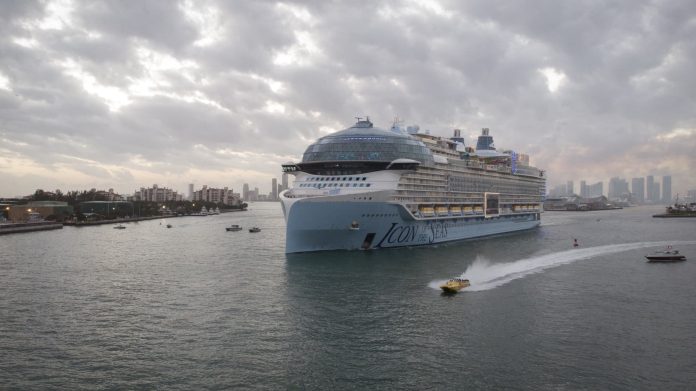
The demand for cruises is still going strong — and it doesn’t appear to be letting up anytime soon.
The industry was the last to recover from the Covid pandemic, but once it did, it has been enjoying strong pricing and booking momentum. While pricing growth is starting to normalize somewhat, it is still well above the rate of inflation, said Patrick Scholes, travel and leisure analyst at Truist.
“Cruise companies are having a moment right now,” he said in an interview with CNBC.
Despite price increases, cruises are still cheaper than land-based lodging. That’s helping the industry stand out as some weakness creeps into other areas of the travel sector. For instance, on Wednesday, Hilton CEO Christopher Nassetta said during the company’s quarterly earnings call that U.S. leisure travel demand “is flat, maybe even a little bit down.”
“The Cruise industry’s continued strength in bookings/demand, whilst cracks form across much of the rest of the travel market, is primarily driven by the combination of the still significant discount to land-based vacations coupled with the relatively elevated service levels,” Barclays analyst Brandt Montour said in a note last week.
As of the second quarter, on a weighted-average basis, the big three cruise operators reported net revenue per diems 17% above 2019, he wrote. Net revenue per diem is the net revenue per passenger cruise day. Caribbean hotel room prices are about 54% ahead of 2019 and U.S. resort prices are up 24%, said Montour, quoting figures from data analytics firm STR.

Carnival CEO Josh Weinstein agreed those so-called cracks elsewhere can help boost his business.
“If that’s true that the consumer is slowing down in other sectors, that really bodes well for us to be able to take them into our demand profile because we will be of value. We give a better experience at a better price than they can achieve elsewhere,” he said in an interview with CNBC’s “Money Movers” after reporting a third-quarter earnings and revenue beat on Sept 30.
Royal Caribbean is set to release its quarterly results on Tuesday, followed by Norwegian Cruise Line Holdings’ report on Wednesday.
Gap wider than it appears
A price gap between hotels and cruises is not new. That’s largely because a lot of hotel demand comes from business travel, while cruise demand is purely from leisure travelers, who are much more price sensitive, explained UBS leisure analyst Robin Farley.
Yet that gap has become even wider than it appears over the last several years, her research shows. That means the cruise lines may have more room to grow, she said.
One reason is the increase in direct bookings for cruises since 2019, according to Farley. That means fewer commissions paid out to travel agents, which is included in gross per diems but netted out of the net per diem line.
“While not disclosed by companies, we believe there has been a meaningful increase in passengers booking directly since 2019,” she wrote. “If the share of cruises booked directly grew by 5 to 10 [percentage points], we calculate that could add close to 200bps to reported net per diems even though it would not mean any growth in gross per diems, or actual ticket price.”
Separately, all three major cruise lines have increased the bundled and presold onboard revenue since 2019, which also is included in their per diems, Farley said. That could suggest another 300 basis point gap between cruise and hotel price growth that doesn’t show up in the metrics, she argued. One basis point equals 0.01%.
Farley sees another potential 350 basis point gap for Royal Caribbean because of its CocoCay private island, which has a water park, zip line and other attractions for which passengers pay an additional cost.

On top of that, all three cruise lines have been rolling out high-speed internet access through Starlink onboard, which could also boost passenger revenue.
“The wider that gap, the better the opportunity for the cruise lines to have upside,” Farley said in an interview with CNBC.
Meanwhile, every bit of increased pricing helps the cruise operators. Truist’s Scholes’ proprietary research on real bookings for next year shows the price is up mid- to high-single digits. Wall Street is only expecting about 3% growth, but it could easily be 5% or more, he said.
That matters because the industry has extremely high fixed costs.
“One extra point of pricing is extremely material to profitability,” Scholes said. “Almost 90% flows through to the bottom line.”
Investing in cruise stocks
Wall Street analysts are largely bullish on cruise operators’ prospects.
“If we think back to 10 years ago before Covid, these companies were competing against themselves,” said Scholes. Now, they are competing against Orlando theme parks and Las Vegas vacations with more attractions available to passengers.
“They are casting a much wider net now,” he said.

Royal Caribbean was the first to up the private-island ante with CocoCay.
“This private island is a really unique offering. It’s not just a nice beach. It has all those amenities that they can charge for,” said UBS’ Farley, who has a buy rating on the stock.
The company’s Icon of the Seas, which officially debuted in January, received a lot of fanfare as the world’s largest cruise ship. Royal Caribbean’s latest ship, Utopia of the Seas, set sail this summer. The fact that the latter offers three- and four-night weekend getaways shows it is really going after first-time cruise passengers, Farley noted.
“They have had so many home runs,” she said.
Royal Caribbean has an average rating of overweight by the analysts covering the stock, but it has about 1% downside to the average price target, per FactSet. The stock has already rallied nearly 56% year to date.
Carnival also has an average rating of overweight by the analysts covering the stock and 12% upside to the average price target, FactSet shows.



 -1.25 (-0.60%)
-1.25 (-0.60%)